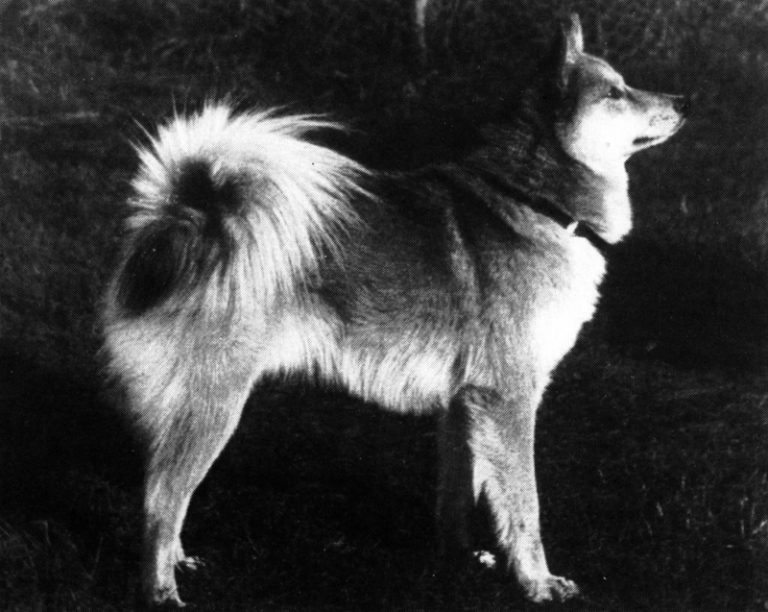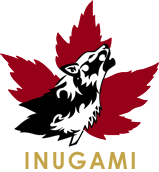History of the Finnish Spitz
Around 100 years AD, the ancestor of the Finnish Spitz were imported in Finland by the Fino-ugrian tribes from Russia. Some of those tribes and their dogs settled in some isolated areas of the far north of Finland. Thus, in the north of Finland a multi-purpose hunting dog was developed, which was to become the Finnish Spitz.
The Finnish Spitz is one of those breeds of dog of which almost no historical writing remains. In fact their origins, where they were and what they looked like are still shrouded in mystery.
The earliest information on the existence of dogs belonging to ancestors of the Finnish people is to be found in linguistic studies, the excavations of the Gorodishche culture (dating from between the stone and bronze age) and artifacts and research which has been stored to give a picture of finnish life.
The first information about this type of dog came from the French explorer de la Martinière in 1875. He speaks of a dark red dog which he claims to have come into contact with as far north as the Murmansk coast. It can be assumed that de la Martinière met with our spitz’s ancestors. The other written information is from Wilhelm von Wright, in 1834. He refers to a foxy looking barking bird dog. It is possible that hunters from central Volga got dogs from others in the same language group or from other surrounding nations. The generic name for dog comes from the Finno-ugric language.
When the Finnish peoples separated from the Volga tribal communities, roaming towards the Baltic Sea, they began a long-term cultural contact with the Germanic and Baltic peoples. Their dogs were subject to great changes in appearance as they interbred with Central European breeds.
The Finnish tribes pressured into moving from the south to their current homelands already had with them dogs suitable for hunting in the Baltic lands. They were demonstrably smaller than the dog of the Finnish- Ugric times. It should be noted that in the new lands which were not rich in game the dogs’ ability to scent, search and give tongue were more important characteristics than catching and killing game.
In a historical context we may consider that the domestic spitz breed’s formation as a type in its own territory began around 100 years AD. Dogs arriving at the south and south-west coasts interbred to a certain extent with dogs already living there, but those dogs settled in Middle-Finland up towards at least the tip of the Gulf of Bothnia and even further to Kainuu kept their original type and greater purity as those areas were not susceptible to the influx of other breeds. To our knowledge it is not recorded that the dog has interbred with wild animals.
Although the dog was useful in many ways and earned his keep, the life of the spitz dog (often referred to as ‘Peni’) was not easy. He had to find his own food by catching small birds and animals while continually seeking protection from wolves in the human dwelling places. A hard struggle for existence which has left permanent breed-specific traits in the Finnish Spitz character. The most typical are quick reactions, suspicion of strangers, faithfulness to his home and a desire to guard his master’s family group.
The Finnish Spitz as a Breed in Finland
By 1880, as advanced means of transportation brought diverse peoples and their dogs together, Finnish Spitz mated with other breeds of dogs, and so the Finnish Spitz found itself on the edge of extinction as a breed.
Realising how serious the situation of the breed was, two experts in forestery, Hugo Richard Sandberg (1849-1930) and Hugo Jonathan Ross (1863-1953), decided to do what they could to save the breed.
It was while hunting in the northern forests that Hugo Roos observed the pure native Finnish Spitz. He realized the many virtues of the pure Finnish Spitz breed and decided to select dogs that were untainted examples of the genuine Finnish Spitz in order to try to revive the breed.
Hugo Sandberg wrote an expert description of the dog’s hunting properties, character and appearance in ‘Sporten‘ magazine in1890.
“A dog living in close contact with his family and sharing their bright and dull days, the Finnish dog also reflects all the characteristics of his owner, the Finn, It is devotedly and self-sacrificingly loyal to him. It also has much more courage than could be expected of such a small dog.”
In this article, Hugo Sandberg talked about the devotion and ‘’self-sacrificing loyalty’’ of this dog toward his master and wrote that this dog had a lot more courage than one would expect from such a small breed. He also wrote paper which he presented to the newly established Kennel Club (1889) asking them to protect this precious and truly National breed. Indeed, in 1892 the Kennel Club decided accept the breed into its register and the standard for the breed’s conformation as suggested by Mr. Sandberg was approved.
A new standard was established back in 1897. At the same time the breed’s name was changed from ‘‘Finnish Barking Bird Dog’’ to ‘‘Suomalais pystykorva – Finnish Spitz’’
Hugo Roos was an active breeder for 30 years and exhibited for even longer. Thanks to his work and his years of careful breeding he has established the foundation for the work of recovering and successfully breeding our actual Finnish Spitz.
In 1946 the breed’s name was once again changed for the current name‘’ Suomenpystykorva’’. It’s translation may not differ in English or in French (Finnish Spitz/Spitz Finlandais) but in Finnish, it’s giving the breed a ‘’name’’ instead of a ‘’description’’.
In total, the Finnish Kennel Club has revised the breed standard six times, and the latest version was confirmed in 1996.
In 1979 (on the Finnish Kennel Club’s 90th anniversary year), the Finnish Spitz was declared Finland’s National Breed and he is also consider as a ‘‘Finnish National Treasure’’.

The Finnish Spitz in Canada
In the late 1960‘s the first Finnish Spitz were imported from Finland, but it wasn’t until the mid’70’s that the breed became firmly established and a community of fanciers developed into what was to become the Canadian Finnish Spitz Club.
In 1974, the breed was recognized by the Canadian Kennel Club and the Canadian Finnish Spitz Club was formed in July 1978.

